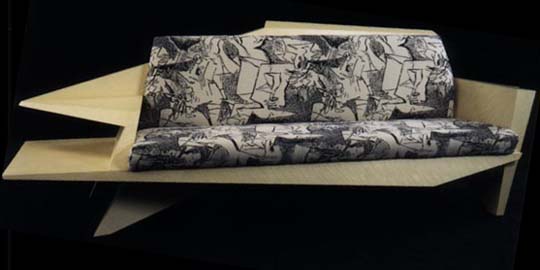
When the editor of Woodworkers Journal wandered by and saw a picture of Janice Smith’s chair, he said what most of us felt when we saw it: “Cool!” If, however, he knew how she did it, he would have been even more amazed.
I got her on the phone to ask about her furniture and she explained that she builds all of it out of plywood. She learned to use plywood when she was teaching at the University of Kansas because she couldn’t find the quality hardwoods she was used to finding when she lived on the East Coast. But she doesn’t use ordinary plywood.
Composite Veneer and Torsion Boxes
Janice uses a composite veneered plywood, made in Italy and available through Brookside, that gives her a consistent grain pattern with a lot of character. Sometimes the veneer is dyed and she has used veneers that range from aqua all the way to white. The grain patterns, as she explains it, are pretty intense, but they are also easy to match when veneering around corners.
The next thing you notice about her furniture is that it doesn’t look like it was constructed of plywood, especially where it gets thicker. For this effect, Janice uses torsion boxes. She prefers them because they are both lightweight and strong. In the case of the pictured chair, the strength is important because it’s designed to be knocked down into five pieces and shipped to galleries on both coasts.
Pursuing Her Style, Paying the Bills
Janice is one of those high school shop students who never lost the woodworking bug. When she searched for colleges, she looked for one with a woodworking program and eventually enrolled at Virginia Commonwealth University. After college, she tried her hand at building renovation and cabinet work for a couple of years before enrolling in the Rhode Island School of Design (RISD).
At the time, Tage Frid was teaching at RISD and she learned a lot about furniture design during her time there. She went on to work in a small furniture shop and learned about torsion box construction from a nearby Rhode Island boat builder. She ended up marrying the owner of the shop and started her own furniture building business as a result.
She didn’t really get a chance to stretch until she got to Kansas. She was teaching at the University and therefore getting a regular paycheck, so she started to experiment with her furniture designs. It was a time “to really work on my style and make it something that reflected my own way of thinking about furniture,” says Janice. Because the work she was doing didn’t have to pay the bills, she found she could truly pursue her own direction.
Janice is back on the East Coast now, living in Philadelphia and making her unique brand of furniture. She is going to continue her focus on seating, both chairs and couches, while she and her husband are busy tearing apart their house. Some of her furniture can be seen at the Wexler Gallery in Philadelphia.





